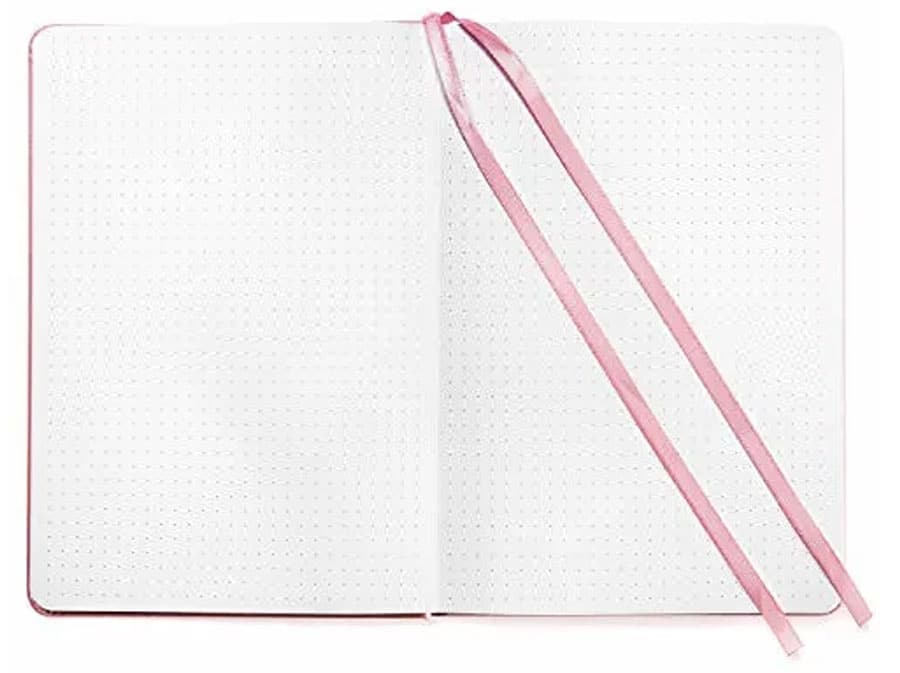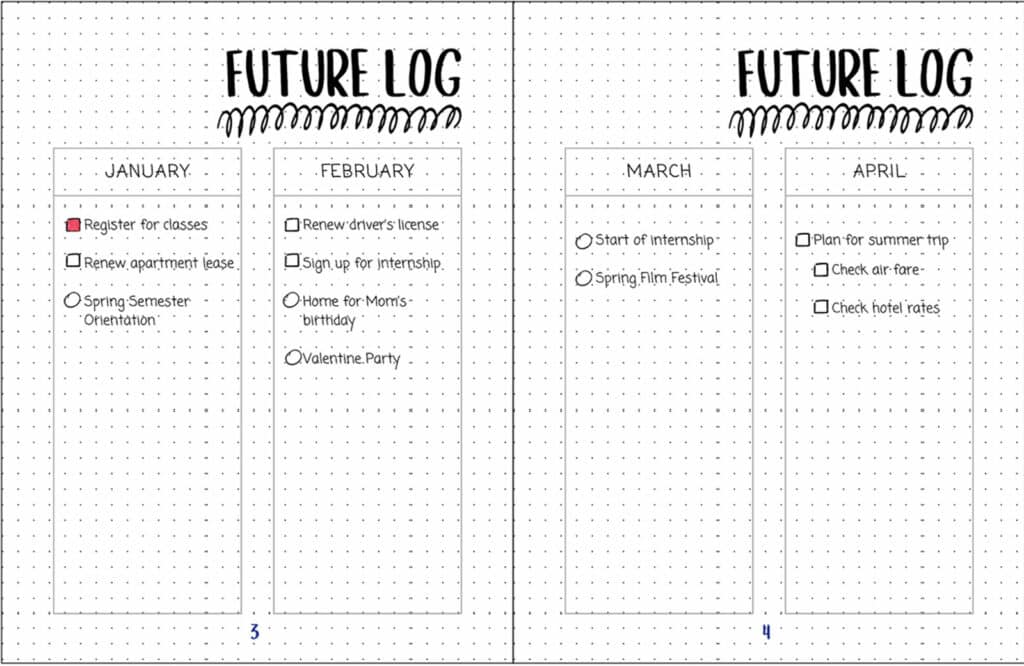- a popular method of personal organization and productivity that involves keeping a record of your thoughts, tasks, and events in a notebook.
- It is based on the core components of rapid logging, modularity, flexibility, migration, and collections.
- The basic unit of a bullet journal is the bullet point. Bullet points are used to track tasks, events, and notes.
- Because the sections of a bullet journal are customizable and flexible, it can be a valuable tool for students, professionals, and anyone else who wants to improve their planning and note-taking skills.
- There are common challenges with bullet journaling, but recognizing these challenges can help you navigate and find solutions to make the bullet journaling experience more seamless.

With today’s digital distractions and information overload, bullet journaling has emerged as a popular choice for those seeking a mindful and organized productivity tool. Created by digital designer Ryder Carroll, bullet journaling is a method of personal information system that involves keeping a record of your thoughts, tasks, notes, and events in a notebook. In this article, we will look into this flexible and customizable system so you can learn to adapt it to your individual needs and preferences.
The Highlighting Method
Core Components of Bullet Journaling
The bullet journaling system is based on the following core components:
- Rapid logging: Rapid logging is a quick and easy way to capture your thoughts and ideas. This involves writing down whatever is on your mind and using bullet points to indicate the type of task or event.
- Modularity: Bullet journaling is modular. You can customize it to fit your individual needs. Add or remove pages, sections, and symbols as needed.
- Flexibility: Bullet journaling is flexible, and you can change your system as needed. There is no right or wrong way to bullet journal.
- Migration: Regularly reviewing your entries is a crucial aspect of the bullet journal system. Migration involves moving incomplete tasks to the next day, week, or month. This reflective process helps you identify priorities and manage your time effectively.
- Collections: Collections are themed lists or groups of related information. They can be anything from a reading list and habit tracker to a gratitude log or a travel itinerary. Collections allow you to organize your thoughts and activities in a way that makes sense to you.
Benefits of Bullet Journaling
Before we start with the basics, here are the benefits of bullet journaling that may encourage you to try it out:
- Improved organization and productivity: Bullet journaling can help you stay organized and productive by providing a central place to track your tasks, events, and ideas.
- Reduced stress and anxiety: Bullet journaling can help to reduce stress and anxiety by providing a sense of control and clarity.
- Promoted creativity and reflection: Bullet journaling can help to promote creativity and reflection by providing a space to brainstorm ideas and track your progress over time.
- Reduced digital distraction: Bullet journaling can help you reduce digital distraction by providing a simple, analog way to track your tasks and events.
Getting Started with Bullet Journaling
To get started with bullet journaling, you will need a notebook or journal. Any notebook will work, but many people prefer to use a dotted grid notebook. This kind of notebook provides a good balance of structure and flexibility.
You will also need a pen or pencil. Some people also like to use colored pens or markers to add visual interest to their bullet journals.

Setting up Your Bullet Journal
Once you have your notebook and pens ready, it is important to set up your bullet journal correctly to make jotting down your notes later easily.
Step 1: Index
The first few pages of your bullet journal should be reserved for an index. This will help you keep track of the different sections of your bullet journal. To create this, simply flip to the first few pages of your notebook and list the different sections that you want to include. Remember that this can be a growing list, so allow an extra page or two so you can add to the list later on. Include page numbers on the items written in your index pages for easy reference when finding specific information.

Step 2: Future Log
This is the section where you can jot down events and tasks that are scheduled beyond the current month. It serves as a quick reference for upcoming commitments or occasions.

Step 3: Monthly Log
Each month typically starts with a monthly log. This spread includes a calendar view for the month and a list of tasks and events. As the month progresses, you can add daily logs to capture more detailed information.

Step 4: Daily Log
The daily log is where you record tasks, events, and notes for a specific day. It follows the rapid logging format and can be as detailed or minimalistic as you prefer. Some people opt for a traditional daily log, while others incorporate additional elements like gratitude entries or weather tracking. Remember to write the date on top of each Daily Log page.

Bullet Journaling Basics
The basic unit of a bullet journal is the bullet point. Bullet points are used to track tasks, events, and notes. Each entry in the bullet journal should be marked with a bullet point that signifies the type of information it represents. Here are some examples, but you can customize the bullet points as long as you stay consistent:
- A box (▢) for tasks
- A circle (o) for events
- A dash (–) for notes
- An exclamation point (!) to indicate a priority task
- A question mark (?) to indicate a task that you need to research or clarify
- An asterisk (*) for items you need to highlight

Together with the bullet points, write short, concise phrases or sentences to jot down your tasks, events, and notes. You can also add additional information, such as due dates, comments, and subtasks.
Marking your bullet journal entries is an essential part of the process. If a task is completed, you can mark it with an “X.” If a task is not yet finished and you want to move it to the following day, week, or month, mark it with a right arrow (→). This process is called “migration,” and this helps you identify priorities and manage your time effectively.
Advanced Bullet Journaling Techniques
Once you have mastered the basics of bullet journaling, you may want to add some advanced techniques that offer a more nuanced and personal approach to productivity.
Time Blocking and Goal Integration
Advanced bullet journaling often involves integrating time blocking with task lists. Instead of merely jotting down tasks, allocate specific time blocks to similar activities. This technique may lead to more productivity; it is more efficient to focus on related tasks than multiple things at a time.

Collections
You can elevate your bullet journal by creating specialized collections for anything else that you want to track, such as books you want to read, habits you want to break, skills you want to master, your daily water intake, or things that you are grateful for every day. This is an excellent way to monitor daily routines and progress and cultivate a positive mindset.

Thematic Spreads
Bullet journaling is very flexible and customizable to fit your preferences and needs. You can break away from the linear structure of traditional bullet journaling by introducing thematic spreads. Dedicate sections of your journal to specific themes, such as personal development, health and wellness, or creative projects. Thematic spreads provide a holistic view of your life and goals.

Visual Goal Mapping
Visualize your goals by incorporating mind maps or goal wheels in your bullet journal. This advanced technique allows you to connect related goals, track dependencies, and visualize the big picture. It’s an excellent way to foster creativity and provide a dynamic overview of your aspirations.

Brain Dump
A bullet journal Brain Dump is a technique used to clear the mind of clutter and capture all thoughts, ideas, and tasks in one centralized place. On a blank page with the heading “Brain Dump,” you can jot down everything that comes to mind — tasks, ideas, goals, questions, notes, events, or random thoughts. Don’t worry about coherence or organization at this stage because you can later review and migrate the items into their specific collections or spreads.

Bullet Journaling for Specific Purposes
Bullet journaling can be a valuable tool for students, professionals, and anyone else who wants to improve their planning and note-taking skills. Here are some tips on how you can customize it to fit your individual needs:
- Students: Students can use bullet journaling to track assignments, deadlines, and exams. They can also use the system to create study plans and track their progress. The bullet journal format can also be used to create notes during class or to review notes before an exam. It is also a helpful tool when brainstorming ideas for essays and projects.
- Professionals: At the workplace, professionals can use bullet journaling to track tasks, meetings, deadlines, and goals. Aside from the daily to-do list, a progress timeline or a goal map for projects can be helpful to monitor milestones and deadlines. Bullet journaling can also be used to brainstorm ideas for new projects or initiatives.
- Creative People: One special thing about bullet journaling is that it inspires creativity. The bullet journal is perfect for creative people because it offers the freedom to design pages and incorporate artistic spreads. The bullet journal can be used to brainstorm, collect inspiration for projects, document the creative process, or even create a portfolio of works.
- Entrepreneurs: Entrepreneurs can use bullet journaling to create their business plans and track goals and progress. A budget tracker or expense tracker can be created to monitor finances. Notes and ideas for new products and services can also be jotted down in a bullet journal.
- Parents: A separate bullet journal can be created to keep track of home and family matters. Parents find bullet journaling useful for tracking their children’s activities, appointments, schoolwork, and routines. Household chores, errands, meal plans, and grocery lists can also be noted in a bullet journal. Trip and vacation planning can also be more efficient with bullet journaling.
Key Tips for Getting Started
- Keep it simple: The beauty of bullet journaling lies in its simplicity. Don’t feel pressured to create elaborate spreads if that doesn’t align with your style. Start with the basics and add complexity as you become more comfortable with the system.
- Experiment with layouts: Bullet journaling is highly customizable, and there’s no one-size-fits-all approach. Experiment with different layouts, trackers, and collections to find what works best for you. Pinterest and Instagram are great sources of inspiration for discovering new ideas.
- Consistency is key: Regularly updating your bullet journal is essential for its effectiveness. Set aside time each day or week to review and plan. Consistency will help you stay on top of your tasks and maintain a clear overview of your life.
Overcoming Common Challenges
While bullet journaling is a highly flexible and effective system for many, there are common challenges that individuals may encounter. Recognizing these challenges can help you navigate and find solutions to make the bullet journaling experience more seamless.
- Lack of time: Some individuals may find it challenging to allocate time for detailed bullet journaling, especially if they have a hectic schedule.
Solution: Simplify your system. Focus on key elements that work best for you. Bullet journaling doesn’t have to be time-consuming; it can be as elaborate or straightforward as you need it to be. Establish a dedicated time for journaling each day or week. Integrating it into an existing routine, such as morning or evening rituals, can make it a habit.
- Overwhelm: As life gets busier, the sheer volume of tasks and information can become overwhelming. Trying to capture everything in the journal may lead to stress rather than relief.
Solution: Prioritize tasks and information. Use symbols or different collections to categorize and organize content. Regularly review and migrate tasks to prevent the feeling of being overwhelmed.
- Perfectionism. Perfectionism can hinder the free-flowing nature of bullet journaling. Some individuals may feel the need for their journal to be aesthetically perfect, leading to procrastination or dissatisfaction with their own entries. There’s also a tendency to compare one’s bullet journal with those in social media, which can lead to pressure to conform to certain styles.
Solution: Remember that the primary function of a bullet journal is functionality. Embrace imperfections and focus on the utility of the system rather than the aesthetics. Experiment with different styles to find what works for your needs.
Conclusion
Bullet journaling is a dynamic and adaptable system that can be tailored to fit any lifestyle. Whether you are a professional, a student, or someone simply looking to bring more organization and mindfulness into your life, the bullet journal offers a versatile and creative solution. Remember that there is no right or wrong way to bullet journal — make it your own and enjoy the journey of self-discovery and productivity.



